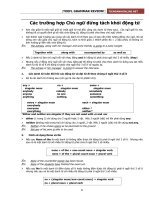Algebra Review
Bạn đang xem bản rút gọn của tài liệu. Xem và tải ngay bản đầy đủ của tài liệu tại đây (295.94 KB, 26 trang )
Equations
To solve an algebraic equation with one variable, find the value of the unknown variable.
Rules for Working with Equations
1. The equal sign separates an equation into two sides.
2. Whenever an operation is performed on one side, the same operation must be performed on the
other side.
3. To solve an equation, first move all of the variables to one side and all of the numbers to the other. Then
simplify until only one variable (with a coefficient of 1) remains on one side and one number remains on
the other side.
CHAPTER
Algebra Review
This chapter reviews key skills and concepts of algebra that you need
to know for the SAT. Throughout the chapter are sample questions in
the style of SAT questions. Each sample SAT question is followed by
an explanation of the correct answer.
6
69
Example
7x Ϫ 11 ϭ 29 Ϫ 3x Move the variables to one side.
7x Ϫ 11 ϩ 3x ϭ 29 Ϫ 3x ϩ 3x Perform the same operation on both sides.
10x Ϫ 11 ϭ 29 Now move the numbers to the other side.
10x Ϫ 11 ϩ 11 ϭ 29 ϩ 11 Perform the same operation on both sides.
10x ϭ 40 Divide both sides by the coefficient.
ᎏ
1
1
0
0
x
ᎏ
ϭ
ᎏ
4
1
0
0
ᎏ
Simplify.
x ϭ 4
Practice Question
If 13x Ϫ 28 ϭ 22 Ϫ 12x, what is the value of x?
a. Ϫ6
b. Ϫ
ᎏ
2
6
5
ᎏ
c. 2
d. 6
e. 50
Answer
c. To solve for x:
13x Ϫ 28 ϭ 22 Ϫ 12x
13x Ϫ 28 ϩ 12x ϭ 22 Ϫ 12x ϩ 12x
25x Ϫ 28 ϭ 22
25x Ϫ 28 ϩ 28 ϭ 22 ϩ 28
25x ϭ 50
x ϭ 2
Cross Products
You can solve an equation that sets one fraction equal to another by finding cross products of the fractions. Find-
ing cross products allows you to remove the denominators from each side of the equation by multiplying each side
by a fraction equal to 1 that has the denominator from the opposite side.
Example
ᎏ
a
b
ᎏ
ϭ
ᎏ
d
c
ᎏ
First multiply one side by
ᎏ
d
d
ᎏ
and the other by
ᎏ
b
b
ᎏ
. The fractions
ᎏ
d
d
ᎏ
and
ᎏ
b
b
ᎏ
both
equal 1, so they don’t change the equation.
ᎏ
a
b
ᎏ
ϫ
ᎏ
d
d
ᎏ
ϭ
ᎏ
d
c
ᎏ
ϫ
ᎏ
b
b
ᎏ
ᎏ
a
bd
d
ᎏ
ϭ
ᎏ
b
b
d
c
ᎏ
The denominators are now the same. Now multiply both sides by the
denominator and simplify.
bd ϫ
ᎏ
a
bd
d
ᎏ
ϭ bd ϫ
ᎏ
b
b
d
c
ᎏ
ad ϭ bc The example above demonstrates how finding cross products works. In the
future, you can skip all the middle steps and just assume that
ᎏ
a
b
ᎏ
ϭ
ᎏ
d
c
ᎏ
is the
same as ad ϭ bc.
–
ALGEBRA REVIEW
–
70
Example
ᎏ
6
x
ᎏ
ϭ
ᎏ
1
3
2
6
ᎏ
Find cross products.
36x ϭ 6 ϫ 12
36x ϭ 72
x ϭ 2
Example
ᎏ
4
x
ᎏ
ϭ
ᎏ
x ϩ
16
12
ᎏ
Find cross products.
16x ϭ 4(x ϩ 12)
16x ϭ 4x ϩ 48
12x ϭ 48
x ϭ 4
Practice Question
If
ᎏ
9
y
ᎏ
ϭ
ᎏ
y
1
Ϫ
2
7
ᎏ
, what is the value of y?
a. Ϫ28
b. Ϫ21
c. Ϫ
ᎏ
6
1
3
1
ᎏ
d. Ϫ
ᎏ
7
3
ᎏ
e. 28
Answer
b. To solve for y:
ᎏ
9
y
ᎏ
ϭ
ᎏ
y
1
Ϫ
2
7
ᎏ
Find cross products.
12y ϭ 9(y Ϫ 7)
12y ϭ 9y Ϫ 63
12y Ϫ 9y ϭ 9y Ϫ 63 Ϫ 9y
3y ϭϪ63
y ϭϪ21
Checking Equations
After you solve an equation, you can check your answer by substituting your value for the variable into the orig-
inal equation.
Example
We found that the solution for 7x Ϫ 11 ϭ 29 Ϫ 3x is x ϭ 4. To check that the solution is correct, substitute 4
for x in the equation:
7x Ϫ 11 ϭ 29 Ϫ 3x
7(4) Ϫ 11 ϭ 29 Ϫ 3(4)
28 Ϫ 11 ϭ 29 Ϫ 12
17 ϭ 17
This equation checks, so x ϭ 4 is the correct solution!
–
ALGEBRA REVIEW
–
71
Equations with More Than One Variable
Some equations have more than one variable. To find the solution of these equations, solve for one variable in terms
of the other(s). Follow the same method as when solving single-variable equations, but isolate only one variable.
Example
3x ϩ 6y ϭ 24 To isolate the x variable, move 6y to the other side.
3x ϩ 6y Ϫ 6y ϭ 24 Ϫ 6y
3x ϭ 24 Ϫ 6y
ᎏ
3
3
x
ᎏ
ϭ
ᎏ
24 Ϫ
3
6y
ᎏ
Then divide both sides by 3, the coefficient of x.
x ϭ 8 Ϫ 2y Then simplify. The solution is for x in terms of y.
Practice Question
If 8a ϩ 16b ϭ 32, what does a equal in terms of b?
a. 4 Ϫ 2b
b. 2 Ϫ
ᎏ
1
2
ᎏ
b
c. 32 Ϫ 16b
d. 4 Ϫ 16b
e. 24 Ϫ 16b
Answer
a. To solve for a in terms of b:
8a ϩ 16b ϭ 32
8a ϩ 16b Ϫ 16b ϭ 32 Ϫ 16b
8a ϭ 32 Ϫ 16b
ᎏ
8
8
a
ᎏ
ϭ
ᎏ
32 Ϫ
8
16b
ᎏ
a ϭ 4 Ϫ 2b
72
Special Tips for Checking
Equations on the SAT
1. If time permits, check all equations.
2. For questions that ask you to find the solution to an equation, you can simply substitute each answer
choice into the equation and determine which value makes the equation correct. Begin with choice c.
If choice c is not correct, pick an answer choice that is either larger or smaller.
3. Be careful to answer the question that is being asked. Sometimes, questions require that you solve
for a variable and then perform an operation. For example, a question may ask the value of x Ϫ 2. You
might find that x = 2 and look for an answer choice of 2. But the question asks for the value of x Ϫ 2
and the answer is not 2, but 2 Ϫ 2. Thus, the answer is 0.
Monomials
A monomial is an expression that is a number, a variable, or a product of a number and one or more variables.
6 y Ϫ5xy
2
19a
6
b
4
Polynomials
A polynomial is a monomial or the sum or difference of two or more monomials.
7y
5
Ϫ6ab
4
8x ϩ y
3
8x ϩ 9y Ϫ z
Operations with Polynomials
To add polynomials, simply combine like terms.
Example
(5y
3
Ϫ 2y ϩ 1) ϩ (y
3
ϩ 7y Ϫ 4)
First remove the parentheses:
5y
3
Ϫ 2y ϩ 1 ϩ y
3
ϩ 7y Ϫ 4
Then arrange the terms so that like terms are grouped together:
5y
3
ϩ y
3
Ϫ 2y ϩ 7y ϩ 1 Ϫ 4
Now combine like terms:
Answer: 6y
3
ϩ 5y Ϫ 3
Example
(2x Ϫ 5y ϩ 8z) Ϫ (16x ϩ 4y Ϫ 10z)
First remove the parentheses. Be sure to distribute the subtraction correctly to all terms in the second set of
parentheses:
2x Ϫ 5y ϩ 8z Ϫ 16x Ϫ 4y ϩ 10z
Then arrange the terms so that like terms are grouped together:
2x Ϫ 16x Ϫ 5y Ϫ 4y ϩ 8z ϩ 10z
–
ALGEBRA REVIEW
–
73
Three Kinds of Polynomials
■
A monomial is a polynomial with one term, such as 5b
6
.
■
A binomial is a polynomial with two unlike terms, such as 2x + 4y.
■
A trinomial is a polynomial with three unlike terms, such as y
3
+ 8z Ϫ 2.
Now combine like terms:
Ϫ14x Ϫ 9y ϩ 18z
To multiply monomials, multiply their coefficients and multiply like variables by adding their exponents.
Example
(Ϫ4a
3
b)(6a
2
b
3
) ϭ (Ϫ4)(6)(a
3
)(a
2
)(b)(b
3
) ϭϪ24a
5
b
4
To divide monomials, divide their coefficients and divide like variables by subtracting their exponents.
Example
ᎏ
1
1
0
5
x
x
5
4
y
y
7
2
ᎏ
ϭ (
ᎏ
1
1
0
5
ᎏ
)(
ᎏ
x
x
5
4
ᎏ
)(
ᎏ
y
y
7
2
ᎏ
) ϭ
ᎏ
2x
3
y
5
ᎏ
To multiply a polynomial by a monomial, multiply each term of the polynomial by the monomial and add the
products.
Example
8x(12x Ϫ 3y ϩ 9) Distribute.
(8x)(12x) Ϫ (8x) (3y) ϩ (8x)(9) Simplify.
96x
2
Ϫ 24xy ϩ 72x
To divide a polynomial by a monomial, divide each term of the polynomial by the monomial and add the quotients.
Example
ᎏ
6x Ϫ 1
6
8y ϩ 42
ᎏ
ϭ
ᎏ
6
6
x
ᎏ
Ϫ
ᎏ
1
6
8y
ᎏ
ϩ
ᎏ
4
6
2
ᎏ
ϭ x Ϫ 3y ϩ 7
Practice Question
Which of the following is the solution to
ᎏ
1
2
8
4
x
x
8
3
y
y
5
4
ᎏ
?
a.
ᎏ
4x
3
5
y
ᎏ
b.
ᎏ
18
2
x
1
4
1
y
9
ᎏ
c. 42x
11
y
9
d.
ᎏ
3x
4
5
y
ᎏ
e.
ᎏ
x
6
5
y
ᎏ
Answer
d. To find the quotient:
ᎏ
1
2
8
4
x
x
8
3
y
y
5
4
ᎏ
Divide the coefficients and subtract the exponents.
ᎏ
3x
8 Ϫ
4
3
y
5 Ϫ 4
ᎏ
ᎏ
3x
4
5
y
1
ᎏ
ϭ
ᎏ
3x
4
5
y
ᎏ
–
ALGEBRA REVIEW
–
74
FOIL
The FOIL method is used when multiplying binomials. FOIL represents the order used to multiply the terms: First,
Outer, Inner, and Last. To multiply binomials, you multiply according to the FOIL order and then add the
products.
Example
(4x ϩ 2)(9x ϩ 8)
F:4x and 9x are the first pair of terms.
O:4x and 8 are the outer pair of terms.
I: 2 and 9x are the inner pair of terms.
L: 2 and 8 are the last pair of terms.
Multiply according to FOIL:
(4x)(9x) ϩ (4x)(8) ϩ (2)(9x) ϩ (2)(8) ϭ 36x
2
ϩ 32x ϩ 18x ϩ 16
Now combine like terms:
36x
2
ϩ 50x ϩ 16
Practice Question
Which of the following is the product of 7x ϩ 3 and 5x Ϫ 2?
a. 12x
2
Ϫ 6x ϩ 1
b. 35x
2
ϩ 29x Ϫ 6
c. 35x
2
ϩ x Ϫ 6
d. 35x
2
ϩ x ϩ 6
e. 35x
2
ϩ 11x Ϫ 6
Answer
c. To find the product, follow the FOIL method:
(7x ϩ 3)(5x Ϫ 2)
F:7x and 5x are the first pair of terms.
O:7x and Ϫ2 are the outer pair of terms.
I: 3 and 5x are the inner pair of terms.
L: 3 and Ϫ2 are the last pair of terms.
Now multiply according to FOIL:
(7x)(5x) ϩ (7x)(Ϫ2) ϩ (3)(5x) ϩ (3)(Ϫ2) ϭ 35x
2
Ϫ 14x ϩ 15x Ϫ 6
Now combine like terms:
35x
2
ϩ x Ϫ 6
–
ALGEBRA REVIEW
–
75
Factoring
Factoring is the reverse of multiplication. When multiplying, you find the product of factors. When factoring,
you find the factors of a product.
Multiplication: 3(x ϩ y) ϭ 3x ϩ 3y
Factoring: 3x ϩ 3y ϭ 3(x ϩ y)
Three Basic Types of Factoring
■
Factoring out a common monomial:
18x
2
Ϫ 9x ϭ 9x(2x Ϫ 1) ab Ϫ cb ϭ b(a Ϫ c)
■
Factoring a quadratic trinomial using FOIL in reverse:
x
2
Ϫ x Ϫ 20 ϭ (x Ϫ 4) (x ϩ 4) x
2
Ϫ 6x ϩ 9 ϭ (x Ϫ 3)(x Ϫ 3) ϭ (x Ϫ 3)
2
■
Factoring the difference between two perfect squares using the rule a
2
Ϫ b
2
ϭ (a ϩ b)(a Ϫ b):
x
2
Ϫ 81 ϭ (x ϩ 9)(x Ϫ 9) x
2
Ϫ 49 ϭ (x ϩ 7)(x Ϫ 7)
Practice Question
Which of the following expressions can be factored using the rule a
2
Ϫ b
2
ϭ (a ϩ b)(a Ϫ b) where b is an
integer?
a. x
2
Ϫ 27
b. x
2
Ϫ 40
c. x
2
Ϫ 48
d. x
2
Ϫ 64
e. x
2
Ϫ 72
Answer
d. The rule a
2
Ϫ b
2
ϭ (a ϩ b)(a Ϫ b) applies to only the difference between perfect squares. 27, 40, 48,
and 72 are not perfect squares. 64 is a perfect square, so x
2
Ϫ 64 can be factored as (x ϩ 8)(x Ϫ 8).
Using Common Factors
With some polynomials, you can determine a common factor for each term. For example, 4x is a common fac-
tor of all three terms in the polynomial 16x
4
ϩ 8x
2
ϩ 24x because it can divide evenly into each of them. To fac-
tor a polynomial with terms that have common factors, you can divide the polynomial by the known factor to
determine the second factor.
–
ALGEBRA REVIEW
–
76
Example
In the binomial 64x
3
ϩ 24x,8x is the greatest common factor of both terms.
Therefore, you can divide 64x
3
ϩ 24x by 8x to find the other factor.
ᎏ
64x
3
8
ϩ
x
24x
ᎏ
ϭ
ᎏ
6
8
4
x
x
3
ᎏ
ϩ
ᎏ
2
8
4
x
x
ᎏ
ϭ 8x
2
ϩ 3
Thus, factoring 64x
3
ϩ 24x results in 8x(8x
2
ϩ 3).
Practice Question
Which of the following are the factors of 56a
5
ϩ 21a?
a. 7a(8a
4
ϩ 3a)
b. 7a(8a
4
ϩ 3)
c. 3a(18a
4
ϩ 7)
d. 21a(56a
4
ϩ 1)
e. 7a(8a
5
ϩ 3a)
Answer
b. To find the factors, determine a common factor for each term of 56a
5
ϩ 21a. Both coefficients (56 and
21) can be divided by 7 and both variables can be divided by a. Therefore, a common factor is 7a. Now,
to find the second factor, divide the polynomial by the first factor:
ᎏ
56a
5
7
ϩ
a
21a
ᎏ
ᎏ
8a
5
a
ϩ
1
3a
ᎏ
Subtract exponents when dividing.
8a
5 Ϫ 1
ϩ 3a
1 Ϫ 1
8a
4
ϩ 3a
0
A base with an exponent of 0 ϭ 1.
8a
4
ϩ 3(1)
8a
4
ϩ 3
Therefore, the factors of 56a
5
ϩ 21a are 7a(8a
4
ϩ 3).
Isolating Variables Using Fractions
It may be necessary to use factoring in order to isolate a variable in an equation.
Example
If ax Ϫ c ϭ bx ϩ d, what is x in terms of a, b, c, and d?
First isolate the x terms on the same side of the equation:
ax Ϫ bx ϭ c ϩ d
Now factor out the common x term:
x(a Ϫ b) ϭ c ϩ d
Then divide both sides by a Ϫ b to isolate the variable x:
ᎏ
x(
a
a
Ϫ
Ϫ
b
b)
ᎏ
ϭ
ᎏ
a
c ϩ
Ϫ
d
b
ᎏ
Simplify:
x ϭ
ᎏ
a
c ϩ
Ϫ
d
b
ᎏ
–
ALGEBRA REVIEW
–
77
Practice Question
If bx ϩ 3c ϭ 6a Ϫ dx, what does x equal in terms of a, b, c, and d?
a. b Ϫ d
b. 6a Ϫ 5c Ϫ b Ϫ d
c. (6a Ϫ 5c)(b ϩ d)
d.
ᎏ
6a Ϫ
b
d Ϫ 5c
ᎏ
e.
ᎏ
6
b
a
ϩ
Ϫ
d
5c
ᎏ
Answer
e. Use factoring to isolate x:
bx ϩ 5c ϭ 6a Ϫ dx First isolate the x terms on the same side.
bx ϩ 5c ϩ dx ϭ 6a Ϫ dx ϩ dx
bx ϩ 5c ϩ dx ϭ 6a
bx ϩ 5c ϩ dx Ϫ 5c ϭ 6a Ϫ 5c Finish isolating the x terms on the same side.
bx ϩ dx ϭ 6a Ϫ 5c Now factor out the common x term.
x(b ϩ d) ϭ 6a Ϫ 5c Now divide to isolate x.
ᎏ
x(
b
b
ϩ
ϩ
d
d)
ᎏ
ϭ
ᎏ
6
b
a
ϩ
Ϫ
d
5c
ᎏ
x ϭ
ᎏ
6
b
a
ϩ
Ϫ
d
5c
ᎏ
Quadratic Trinomials
A quadratic trinomial contains an x
2
term as well as an x term. For example, x
2
Ϫ 6x ϩ 8 is a quadratic trino-
mial. You can factor quadratic trinomials by using the FOIL method in reverse.
Example
Let’s factor x
2
Ϫ 6x ϩ 8.
Start by looking at the last term in the trinomial: 8. Ask yourself, “What two integers, when multiplied together,
have a product of positive 8?” Make a mental list of these integers:
1 ϫ 8 Ϫ1 ϫϪ82 ϫ 4 Ϫ2 ϫϪ4
Next look at the middle term of the trinomial: Ϫ6x. Choose the two factors from the above list that also add
up to the coefficient Ϫ6:
Ϫ2 and Ϫ4
Now write the factors using Ϫ2 and Ϫ4:
(x Ϫ 2)(x Ϫ 4)
Use the FOIL method to double-check your answer:
(x Ϫ 2)(x Ϫ 4) ϭ x
2
Ϫ 6x ϩ 8
The answer is correct.
–
ALGEBRA REVIEW
–
78









